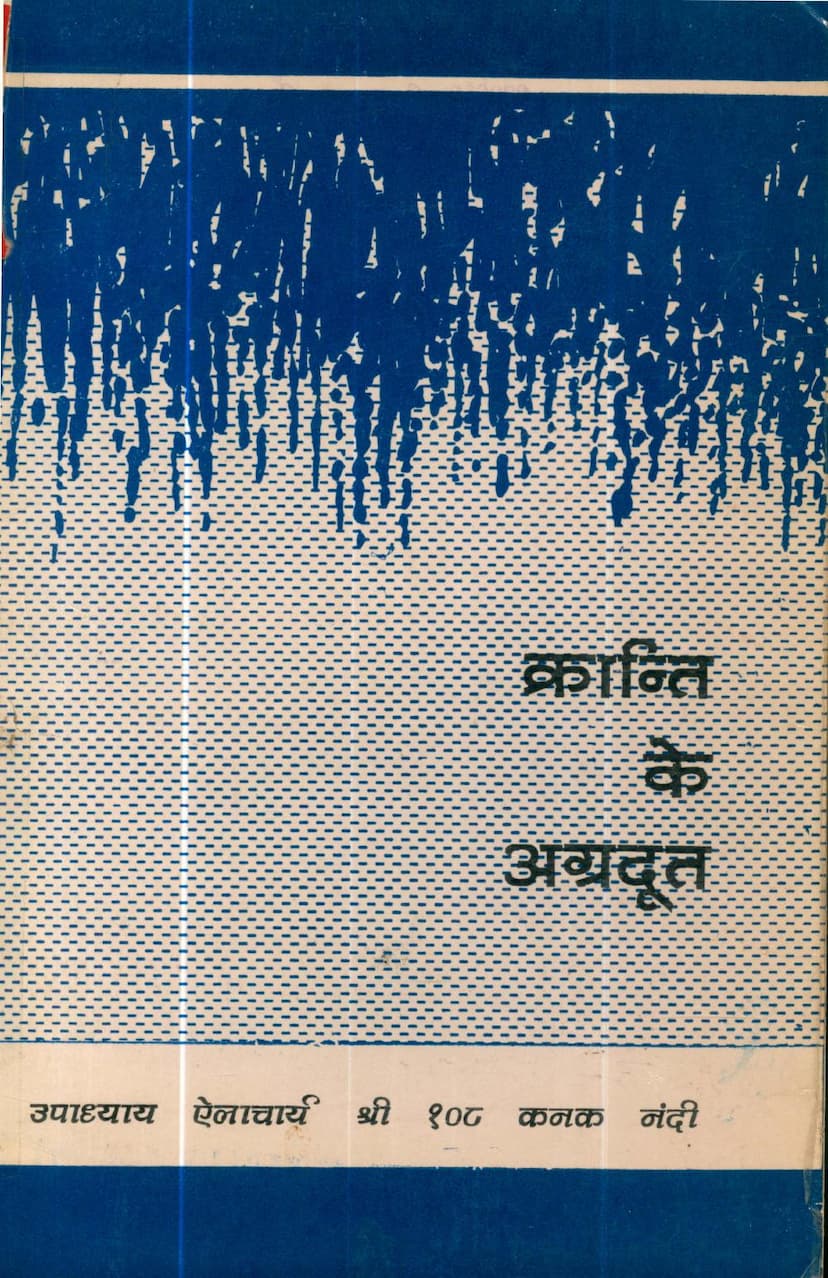Kranti Ke Agradut
Added to library: September 2, 2025

Summary
This comprehensive summary is based on the provided Jain text, "Kranti Ke Agradut" (Frontrunners of Revolution) by Upadhyay Elacharya Shri 108 Kanak Nandi. The book focuses on the lives and teachings of the Tirthankaras, revered figures in Jainism, who are presented as revolutionary leaders who guide humanity towards spiritual liberation and social upliftment.
Here's a breakdown of the key themes and content:
Core Concept: Tirthankaras as "Frontrunners of Revolution"
The central thesis of the book is that the Tirthankaras are not just spiritual leaders but also catalysts for profound societal and spiritual "revolutions." They bring about change by:
- Dispelling Ignorance: They illuminate the path of truth, non-violence, and righteousness, freeing humanity from the darkness of ignorance, superstition, and harmful traditions.
- Establishing Ethical Systems: They lay down principles for righteous living, social harmony, and moral conduct, revolutionizing human behavior and societal structures.
- Promoting Spiritual Liberation: Their ultimate goal is to guide individuals towards breaking free from the cycle of birth and death, achieving ultimate bliss and enlightenment.
Key Aspects of Tirthankaras and their Revolution:
-
The Role of Tirthankaras:
- Timeless Guidance: In every epoch (chaturth kal), 24 Tirthankaras appear to guide humanity. The current era has seen 24 Tirthankaras, from Adinath to Mahavir.
- Divine Mandate: Their advent is necessitated by the spiritual degeneration of humanity, when people stray from the path of righteousness due to excessive indulgence in worldly pleasures and violence. They are born to re-establish the true path.
- Extraordinary Birth: The arrival of a Tirthankara is preceded by auspicious signs in the world, and their birth itself brings about positive transformations in nature, leading to prosperity, health, and peace.
-
The Path to Becoming a Tirthankara:
- Generations of Austerity: Tirthankara status is not attained easily but is the result of immense self-discipline, penance, service, love, friendship, non-violence, self-control, and the cultivation of equanimity over countless lifetimes.
- "Tirthankara Nama Karma": This unique karmic accumulation is essential for becoming a Tirthankara. It is achieved through the practice of 16 specific virtues and qualities (Shodash Karan Bhavna), including:
- Purity of Vision (Darshan Vishuddhi)
- Humility and Reverence (Vinay Sampannata)
- Unwavering observance of vows (Sheel Vraton ka Atiyachar Rahit Palan)
- Constant application of knowledge (Gyan me Satat Upyog)
- Sense of Urgency and Devotion (Sanveg)
- Charity and Austerity according to capacity (Tyag and Tap)
- Service to the Holy (Sadhu Samadhi and Vaiyavrittya)
- Devotion to the enlightened, teachers, and scriptures (Arhant, Acharya, Bahushrut, Pravachan Bhakti)
- Adherence to essential duties (Avashyak Kriyaon ko na Chhodna)
- Promoting the path of liberation (Moksha Marg ki Prabhavna)
- Love for the teachings (Pravachan Vatsalya)
-
The Five Sacred Events (Panch Kalyanaka):
- Incarnation (Garbha Kalyanaka): Marked by celestial events like gem showers, signaling the divine conception.
- Birth (Janma Kalyanaka): Accompanied by supernatural phenomena and the manifestation of 10 "Atishayas" (extraordinary qualities) in the Tirthankara's body, such as being sweat-free, having pure blood, and possessing immense strength.
- Renunciation (Diksha Kalyanaka): The momentous decision to leave worldly possessions and embrace asceticism, often involving a grand ceremony orchestrated by celestial beings.
- Attainment of Omniscience (Kevalgyan Kalyanaka): The ultimate spiritual awakening, leading to infinite knowledge, perception, bliss, and energy. This is marked by the body levitating 5000 bows above the ground.
- Liberation (Moksha Kalyanaka): The final release from all karmic bonds, achieving eternal peace and bliss.
-
The Samavasharan:
- Divine Assembly Hall: A magnificent, divinely created assembly hall where the Tirthankara delivers sermons.
- Universal Audience: Attended by humans, celestial beings (devas), and even animals, all sitting together in harmony, transcending their natural animosities.
- Divine Speech (Divya Dhwani): The Tirthankara's discourse is a mystical sound that can be understood by all beings in their own language, conveying profound truths about non-violence, truth, non-stealing, celibacy, non-possession, equanimity, and universal brotherhood.
- Miraculous Manifestations: The Samavasharan is adorned with numerous miracles and divine attributes, known as "Atishayas" and "Pratiharyas," further emphasizing the Tirthankara's greatness.
-
The Concept of "Revolution" (Kranti):
- Beyond Political Upheaval: The book differentiates between mere political revolutions and the profound spiritual and ethical revolution brought about by the Tirthankaras.
- Inner Transformation: The true revolution is an inner one, achieved through self-purification, ethical conduct, and the eradication of negative emotions.
- Social Order: This inner transformation leads to a just and peaceful societal order, where violence and discord are replaced by peace and harmony.
-
The Contribution of Other Historical Figures:
- While Tirthankaras are the primary focus, the book also briefly touches upon other significant figures in Jain history who contributed to social and political order, such as Chakravartis (universal emperors) and other prominent personalities.
Overall Message:
"Kranti Ke Agradut" emphasizes the transformative power of the Tirthankaras' lives and teachings. They are presented as the ultimate revolutionaries who initiated a "revolution of consciousness," leading humanity towards spiritual awakening, ethical living, and ultimate liberation. Their example inspires readers to strive for inner purity and contribute to a more peaceful and just world. The book serves as an informative and inspiring guide to understanding the profound impact of these divine beings in Jainism.